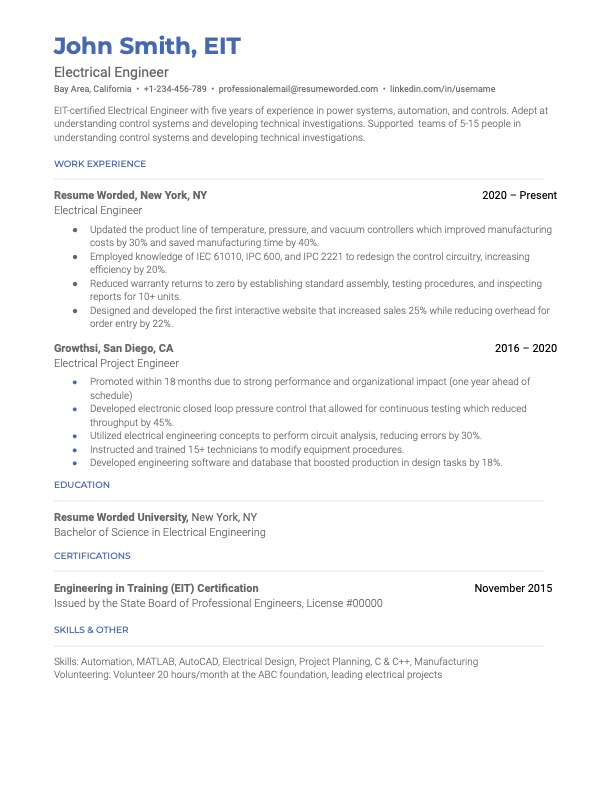If you’re a budding engineer, you’ve probably considered putting Engineer in Training (EIT) on your resume. If your question is “should I put EIT status on my resume?” the answer is: Yes!
EIT certification is a great way to differentiate yourself from everyone else in the currently overcrowded job market. It shows expertise in the engineering field and a commitment to ongoing professional learning, which are two things recruiters are particularly looking for.
If you’re looking for real examples of how to put EIT status on your resume, including ready-made bullet points, keep reading — but first, let’s take a look at where EIT certifications belong.
Where to put EIT certification on a resume
EIT certification can go in one of two places on your resume: The Education section or a separate Certifications section.
You should list EIT in the Education section of your resume if:
- You’re a current student or recent graduate
- You have a formal engineering degree
You should list EIT in a stand-alone Certifications section if:
- You have work experience in your field
- You want to highlight ongoing professional development and expertise
Now that that’s sorted, let’s take a look at how to list EIT in each of these sections.
Examples of EIT on a resume
Listing EIT in your Education section
Here’s an example of what EIT certification should look like in the Education section of your resume:
Resume Worded University, 2022
Bachelor of Science in Civil Engineering
Engineering in Training (EIT) Certification, January 2024
Listing EIT in a Certifications section
Here’s an example of putting EIT in a Certifications section:
Engineering in Training (EIT) Certification, January 2024
Issued by the State Board of Professional Engineers, License #00000
EIT resume example
Here’s a finished resume that includes EIT certification:

If you're unsure whether you've listed your EIT certification the right way, upload your resume to the tool below – it will let you know if you have chosen the best section of your resume to highlight your EIT certification and accomplishments.
What to highlight on your engineering resume
While EIT status looks great on a resume, it isn’t going to land you a job all by itself. You should also highlight related skills and accomplishments like:
- Relevant coursework you completed
- Engineering projects you worked on
- Skills you developed during your education and training
- Professional accomplishments
Let’s take a look at some examples.
Engineering coursework on a resume
You should highlight any relevant coursework in your Education section, just below the name of your degree. You can take this off again as you gain more relevant experience, but if you’re just starting out, this is a good way to emphasize your specific skill sets.
Here’s an example:
Resume Worded University, 2022
Bachelor of Science in Civil Engineering
Relevant coursework: Fluid Mechanics, Materials Science, and Structural Analysis
Engineering projects on a resume
You can list projects in their own section if they were personal or educational projects, or in your Work Experience section if they were part of your professional experience. Either way, be sure to use specific, measurable language and include quantifiable results when possible.
You can do this by highlighting metrics like time savings, revenue generation, or improved operational efficiency.
For example:
Collaborated on the design and construction of a sustainable water treatment facility, reducing water usage by 20% and saving the client $50,000 in annual operating costs.
Engineering skills on a resume
The obvious place for technical skills is in your skills section, but you should also try to weave these into your professional bullet points. Describing specific skills using technical language and industry-specific terminology not only gives prospective employers a sense of what you can do, it also shows that you’re familiar with the industry and know how to put all that EIT theory into practice.
For example, instead of just listing AutoCAD and Revit in your skills section, you should also include a related accomplishment like:
Improved proficiency in AutoCAD and Revit by completing a professional development course, resulting in increased efficiency and accuracy in drafting and design work.
Use the tool below to get a list of technical skills and engineering keywords relevant to your industry.
Transferable skills on a resume
Technical skills aren’t everything — even in engineering. Hiring managers also want to see evidence of soft skills like:
- Design and analysis
- Project management
- Technical writing
- Teamwork
- Communication
Here are some examples you can use or tweak for your own resume.
Problem solving skills:
Managed multiple engineering projects from conception to completion, ensuring compliance with regulatory standards and on-time delivery and resulting in a 95% project success rate.
Technical writing skills:
Prepared technical reports and proposals for clients, providing clear and concise explanations of complex engineering concepts.
Teamwork skills:
Collaborated with a team of engineers to design a sustainable building solution that reduced energy consumption by 20%.
Communication skills:
Authored technical reports and presentations, utilizing effective communication skills to convey complex information to a variety of stakeholders.
For more suggestions of resume-worthy bullet points, or for feedback on your own resume, why not try out the Score My Resume tool?
EIT vs FE
Before you finalize your resume, it’s worth understanding the difference between EIT and FE.
Fundamentals of Engineering (FE) certification is a prerequisite for taking the Professional Engineer (PE) exam.
Engineer in Training (EIT) is the first step towards becoming a licensed professional engineer. It’s worthwhile including EIT on your resume even if you haven’t yet obtained FE certification, because EIT status still demonstrates a commitment to professional development and expertise in the engineering field.










